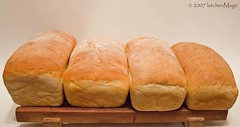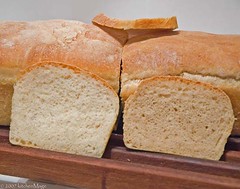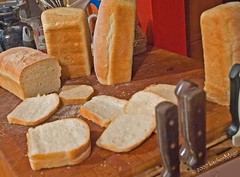Beth: Potato Bread
When theKid was a young'un, I faced a challenge that I am sure is common to parental units across the country: white bread lust.
For reasons perhaps best explained by marketing, a lot of kids — even those who usually make sane food choices—seem to prefer bland, white bread. Sandwiches, toast, pretty much anything has to be white bread, but especially sandwiches. And kids eat lots of sandwiches. (hmmm, kids, sandwiches, Kevin, sandwiches... interesting....) Not very healthy and awfully boring. The white bread — not Kevin!
Then there was the cost of a decent loaf of white bread, which was simply exorbitant. Yet, even as a single mother on a tight budget, the affordable white bread in the shiny primary-color dotted bag was just too awful to contemplate. (The only thing I ever Wondered was who was buying that stuff!)
Whole Wheat Potato Bread
Potatoes have many positive effects on bread: yeast loves it, bread is softer and stays fresh longer, and bread dough with potatoes does not have to be mixed as long as bread without potatoes—amazing but apparently true! One of the more useful effects however, is an increased tolerance for whole wheat flour in the dough.
I used two cups of white whole wheat in one of my experiments and, with a few minor adjustments, I think this recipe would do nicely for anyone who wants a whole wheat take on this bread. As with all of bread baking, pay attention to the feel of the dough and adjust the ingredients where they seem to need it. Here is what you need to do differently, and why:
New first step: Mix the water, white whole wheat flour and yeast, cover and let it sit for ten minutes. This insures that the heavier whole wheat flour is totally hydrated before you start mixing the rest of the dough.
The white whole wheat flour absorbs more water, so add a little. I'd suggest a quarter of a cup. You may need to add a bit more when you are adding the rest of the flour, if it seems too dry to absorb all of it.
Let the bread proof until it is actually doubled in bulk. As you can see from the photo of the side by side white and white whole wheat loaves, I underproofed mine a bit. (I was nervous about it falling and it looked done. Oh well, live and learn.)
You can probably substitute more white whole wheat for white, although at some point you might need to add a little more yeast or a tablespoon of gluten if you have it around. The potatoes make this dough pretty forgiving.
I started sneaking in bits of leftover cooked cereal, mashed potatoes, rice, and other things that seemed to have a complementary flavor and texture. This was surprisingly effective and had the bonus of helping me cut down on wasted food, which mattered a lot on my very tight budget.
Potato bread—soft, almost billowy, yet chewy enough to have some substance—was one of my favorites. Fresh herbs add a lovely depth to the flavor; rosemary and thyme are particularly good. This also makes wonderful dinner rolls; I like them with soup because they hold together well when dipping.
These days, I only bake bread for theKid when she makes the trek from theCity to evenTinierTown and it's been a long time since I had to sneak anything into her bread. I still love potato bread, though, and since I can never seem to make the right amount of mashed potatoes it's something I can make fairly regularly.
kitchenMage's Potato Bread
water | 2 cups | 475 ml | 16 ounces | 450 grams
bread flour | 5 1/2 cups | 1070 ml | 20 1/4 ounces | 570 grams
instant yeast | 2 teaspoons | 12 ml | 1/4 ounce | 7 grams
mashed potatoes | 1 1/4 cup | 350 ml | 8 ounces | 225 grams
butter | 2 tablespoons | 30 ml | 1 ounce | 28 grams
all purpose flour | 1 cup | 235 ml | 4 1/2 ounces | 125 grams
salt | 1 tablespoon | 15 ml | 1/2 ounces | 15 grams
Notes:
I based this recipe on mashed boiled potatoes with nothing added and used the water from the potatoes in the bread. If you want to do this, measure the water and raw potatoes then cook. When the potatoes are done, do not drain them, just mash them in the water. Then measure the mixture again and if it's not quite the same, add water until it is.
If you are using leftover mashed potato, you will probably need to add a little extra flour to make up for additions to the potatoes, such as milk or butter. You will have to judge this when you are making it.
In mixing bowl, combine water, potatoes, yeast and flour and mix until well combined. Add the butter and mix until it is integrated into dough. The dough will still be very soft. Cover and let rest on the counter for 20 minutes.
Add the salt to the dough when you do the next step.
If you are using a mixer: Use the dough hook and mix it on medium while you sprinkle in the all-purpose flour a tablespoonful at a time. When the absorption of the flour starts to slow down, turn it out on a well-floured counter and knead until the dough is smooth and supple, but no longer tacky.
If you are making the dough by hand: Spread the cup of all-purpose flour on the counter and knead for 4-5 minutes, adding more flour if needed. Knead until the dough is, as Kevin would say, smooth as a baby's...um, never mind, we got labeled as an adult site by one of those net-filtering software things because I said "bread p**n" once. Geez.
Roll the dough in flour, put it in a clean bowl, cover and let rise until doubled in bulk (about an hour).
Turn the dough out on a lightly floured counter, divide in half and shape into loaves. Grease two loaf pans. Put the shaped loaves in the pans and let rise until doubled in bulk (about an hour).
Preheat oven to 375°f / 175°c. Bake bread for 35 minutes or until golden brown (~195°f / 90°c internal temperature). Turn out of pans onto cooling rack for at least an hour.
This last picture? Just a bit of truth in blogging. Just in case we put up a convincing front that it is all we just make a recipe up in fifteen minutes and bake one loaf and it is perfect and our kitchens are always clean. As if!
Technorati: Food | recipe | baking | bread | artisanal | artisan <| bread baking | potato bread | sandwich bread | white bread
Labels: basic white bread, kitchenMage, sandwich bread, white bread
Click here to continue reading the post and comments...










 Click here to see A Year of Bread in pictures."
Click here to see A Year of Bread in pictures."